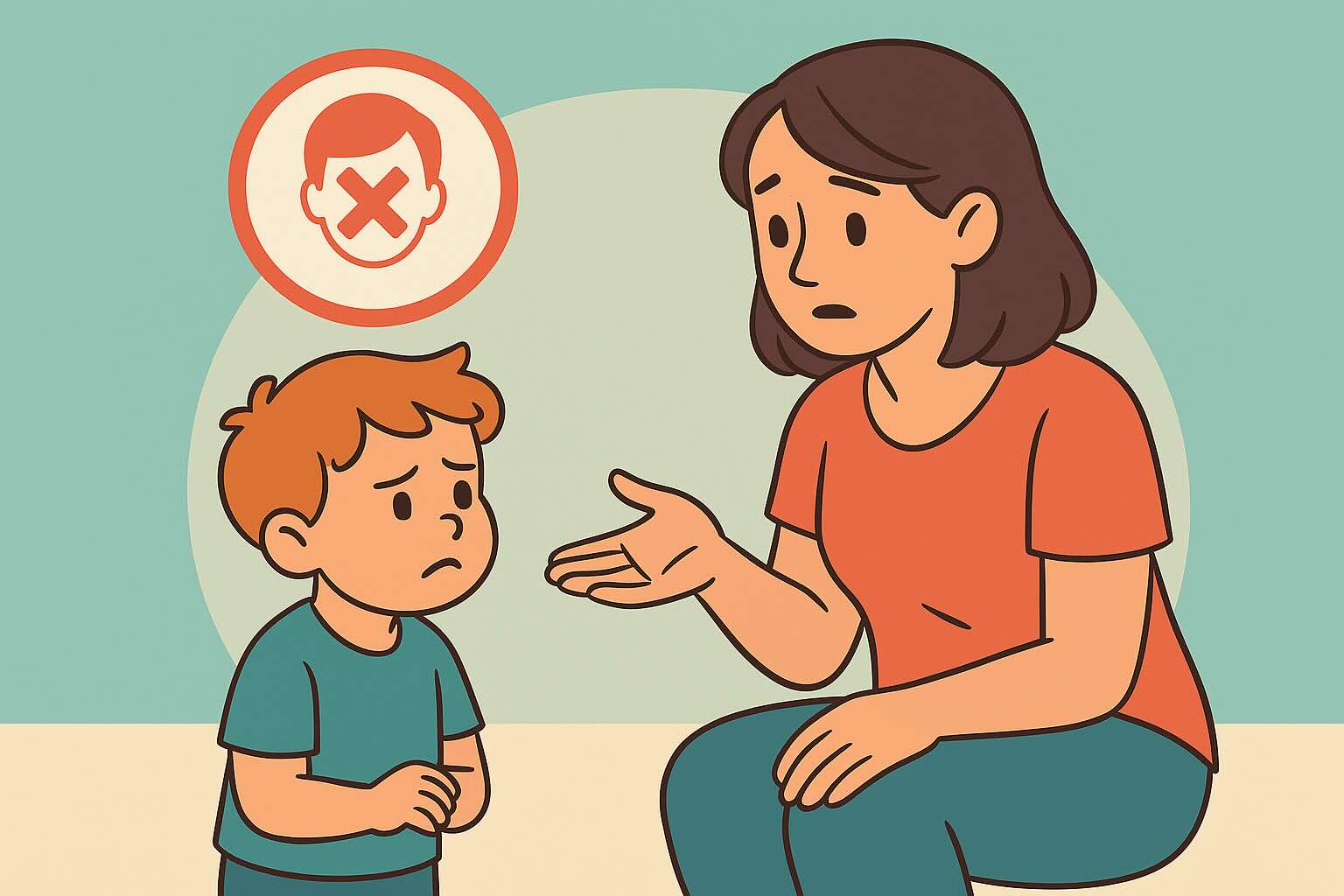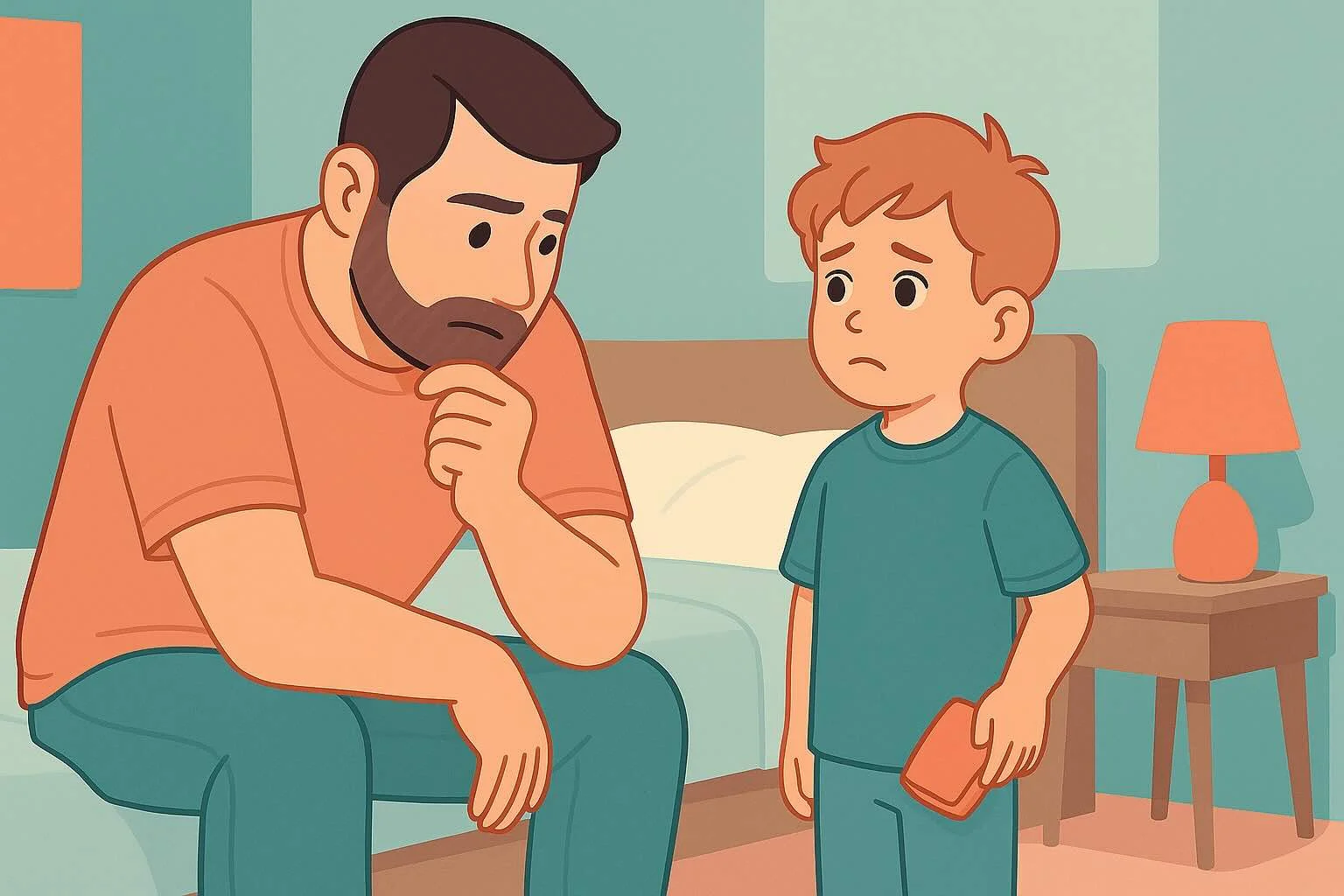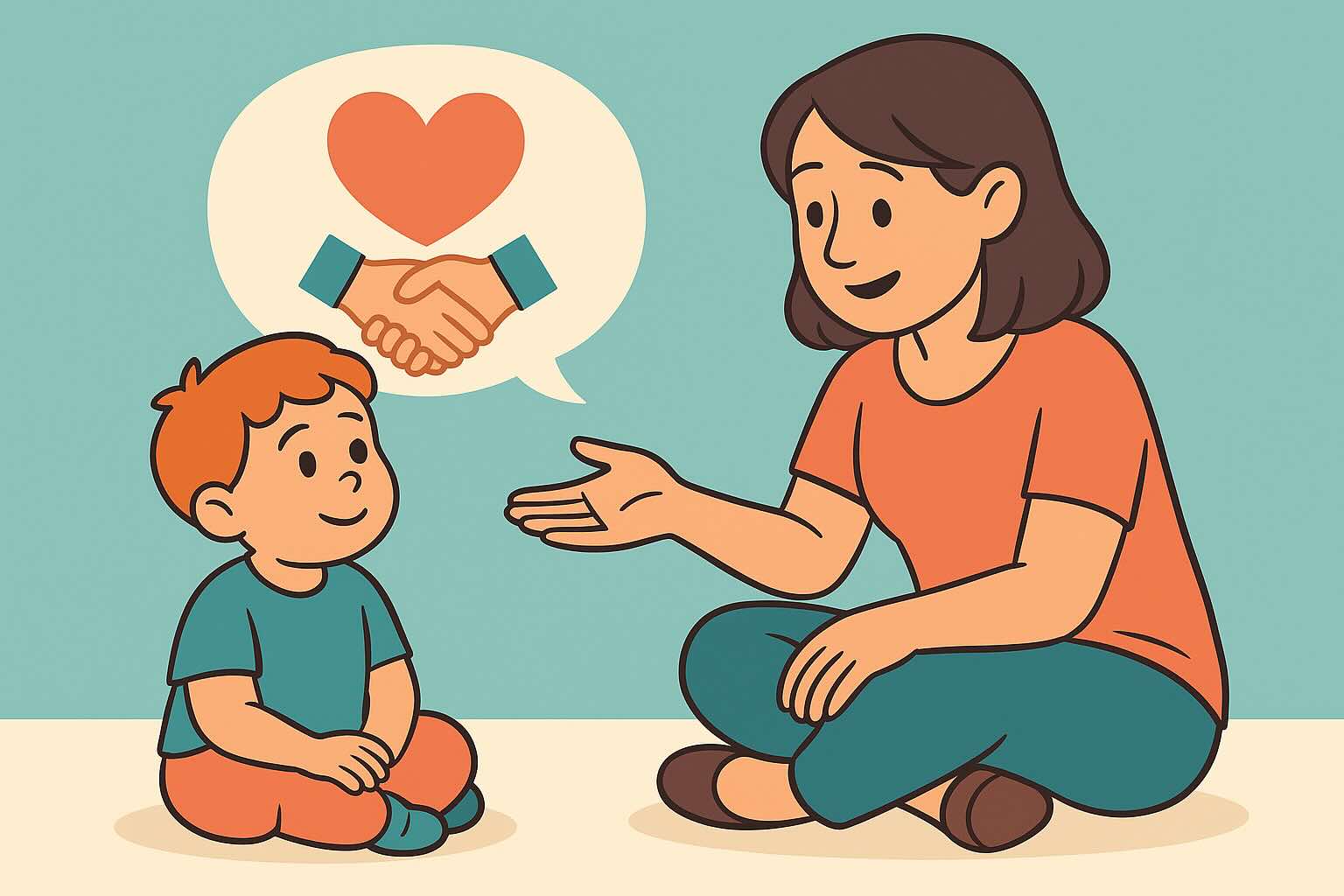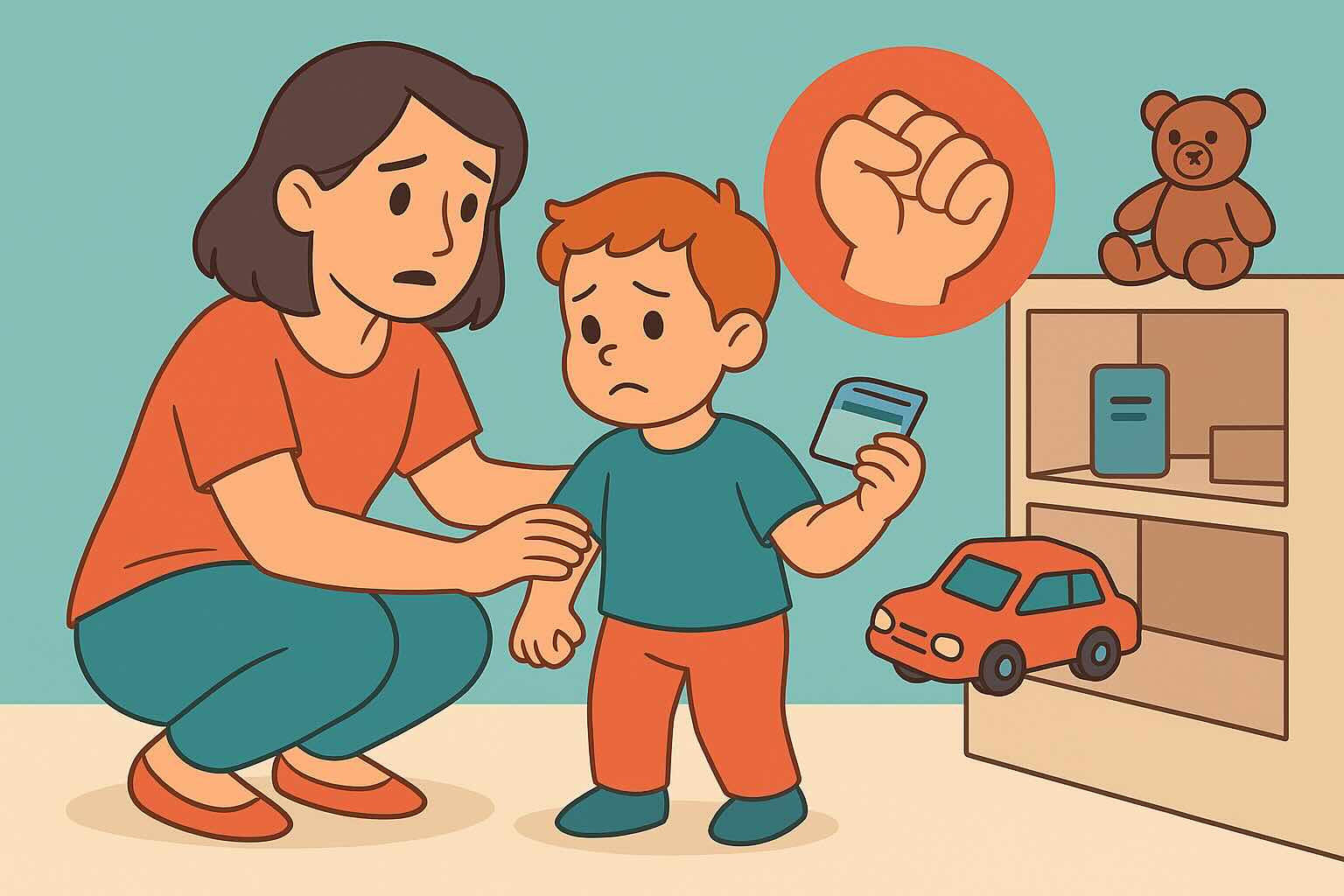Why Children Lie: 7 Responses That Build Honesty Without Shame


If you've ever caught your child telling you they already brushed their teeth when you know they didn't, or insisting they "didn't do it" when evidence suggests otherwise, you're not alone. Lying is an incredibly common part of child development that typically begins around age 5, and it's actually a sign of normal cognitive growth.
This comprehensive guide will help you understand why your child lies and provide you with evidence-based strategies to respond in ways that build trust and honest communication. No more guessing games, no more power struggles—just practical tools that address the real reasons behind lying behavior.
For specific age-related guidance, also check out our imagination vs. lying guide for younger children and our building trust after lying strategies. See also our response scripts guide and stealing behavior guide. If lying is part of broader behavioral challenges, explore our managing power struggles and cooperative parenting approaches.
What You'll Learn in This Guide
- The Real Reasons - Why children lie and what they're really trying to communicate
- Developmental Timeline - When lying typically starts and how it evolves
- The 3-Step Response Method - Exactly how to respond when you catch your child lying
- Prevention Strategies - How to create an environment where truth-telling feels safe
- Age-Specific Approaches - Different techniques for 3-4 year olds vs. 5-7 year olds
- Building Trust - How to strengthen honest communication long-term
- When to Seek Help - Red flags that indicate professional support is needed
Estimated reading time: 12 minutes
Understanding Why Children Lie: The Psychology Behind the Behavior
Your Child's Developing Mind: Why Lying Happens
Before age 5, what might look like "lying" is usually imagination, wishful thinking, or memory confusion. True intentional lying requires cognitive abilities that develop around age 5:
- Theory of mind: Understanding that others have different knowledge than they do
- Executive function: The ability to plan and think ahead about consequences
- Emotional regulation: Managing complex feelings like guilt, shame, or fear
- Language development: Understanding the concept of truth vs. falsehood
This means when your 5-year-old lies, they're actually demonstrating important cognitive development, even though the behavior needs guidance.
The 3 Primary Reasons Children Lie (And What They Really Need)
Reason 1: Avoiding Unwanted Tasks or Activities
What it sounds like:
- "I already brushed my teeth"
- "I can't find my backpack" (when asked to pack it)
- "My homework is already done"
- "I already cleaned my room"
What they're really expressing: "I don't want to do this task right now. It feels hard or overwhelming, and I wish I could avoid it."
The underlying emotion: Avoidance, feeling overwhelmed, or simple preference for something else.
Reason 2: Getting Out of Trouble
What it sounds like:
- "I didn't hit my sister"
- "It wasn't me who broke it"
- "I don't know what happened"
- "Someone else did it"
What they're really expressing: "I'm scared of getting in trouble. I don't want you to be mad at me or disappointed in me."
The underlying emotion: Fear of consequences, shame about their actions, or worry about losing your love and approval.
Reason 3: Seeking Praise and Approval
What it sounds like:
- "I did it all by myself" (when they had help)
- "The teacher said I was the best in class"
- Exaggerating accomplishments or abilities
- Making up impressive stories about themselves
What they're really expressing: "I want you to be proud of me. I want to feel special and important."
The underlying emotion: Desire for connection, feeling inferior to others, or competing for attention.
The 3-Step Method for Responding to Lying
This research-based approach helps you address the behavior while strengthening your relationship and teaching honest communication.
Step 1: Stay Calm and Look Inward
Before responding to your child, check in with yourself:
- Take a deep breath and remind yourself that lying is developmentally normal
- Notice your own emotional reaction (anger, disappointment, panic)
- Remember that your child isn't lying to you—they're expressing an underlying need
What NOT to do:
- Don't immediately accuse: "Don't lie to me!"
- Don't ask "Why did you lie?" (this creates defensiveness)
- Don't launch into lectures about honesty
Step 2: Understand the Emotion Behind the Lie
Look for the underlying need:
- Are they trying to avoid something difficult?
- Are they afraid of getting in trouble?
- Are they seeking approval or connection?
Validate the emotion while addressing the behavior:
- "I think you don't want to brush your teeth right now. It's okay to not feel like doing something."
- "I have a feeling you're worried about getting in trouble. No one likes getting in trouble."
- "It sounds like you really want me to be proud of you. I can understand that."
Step 3: Guide Them Toward Truth-Telling
Create safety for honesty:
- "You can tell me when you don't feel like doing something. You still need to do it, but you can tell me how you feel."
- "It's okay to make mistakes. Everyone makes mistakes. What's important is that we can talk about them."
- "I'm always proud of you for trying, not just for being perfect."
Use collaborative problem-solving:
- "What could help make brushing teeth feel easier?"
- "How can we handle it next time when you make a mistake?"
- "What would help you feel proud of yourself from the inside?"
Age-Specific Strategies for Different Developmental Stages
Ages 3-4: The Fantasy and Reality Phase
At this age, children are still learning the difference between imagination and reality. What looks like lying is often:
- Fantasy play: "There's a dragon in my room"
- Wishful thinking: "I already had my nap" (hoping it's true)
- Memory confusion: Mixing up what they want to happen with what did happen
How to respond:
- Go with imagination: "Tell me more about this dragon! What does it look like?"
- Gently introduce reality: "In your imagination, you already had your nap. In real life, it's nap time now."
- Don't correct harshly: Focus on enjoying their creativity while teaching the difference
Ages 5-6: The Intentional Testing Phase
This is when true purposeful lying begins. Children are testing boundaries and learning about cause and effect.
Common lying patterns:
- Denying obvious things they did
- Making up elaborate stories to avoid consequences
- Testing whether you'll believe their stories
How to respond:
- State facts calmly: "I see the broken cup. Something happened here."
- Avoid interrogation: Don't ask "Did you break this?" when you know they did
- Focus on solutions: "Let's clean this up together and figure out how to be more careful."
Ages 6-7: The Social Comparison Phase
Children this age are very aware of comparisons with peers and siblings. Lying often stems from:
- Feeling inferior or jealous
- Wanting to fit in socially
- Seeking special attention or status
How to respond:
- Address comparison feelings: "It sounds like you wish you were as fast as your sister."
- Build internal confidence: "What are you proud of about yourself?"
- Teach coping with disappointment: "It's hard when someone else gets something we want."
Creating an Environment Where Truth-Telling Feels Safe
Reduce Fear-Based Reactions
Instead of punishment-focused responses:
- "You're in big trouble for lying!"
- "Liars don't get privileges!"
- "I can't trust you anymore!"
Try connection-focused responses:
- "Thank you for telling me the truth, even though it was hard."
- "I appreciate your honesty. Now let's figure out what to do."
- "Everyone makes mistakes. What matters is that we can talk about them."
Use Reflective Family Conversations
Have regular discussions about emotions:
- "What does it feel like when you don't want to do something?"
- "Has anyone ever felt worried about getting in trouble?"
- "What makes people feel proud of themselves?"
Share your own examples:
- "I remember when I was little, I sometimes told my mom I already cleaned my room when I didn't."
- "Sometimes I don't feel like doing the dishes, even as a grown-up."
Implement Natural Consequences vs. Punishments
Focus on learning rather than suffering:
- If they lie about homework: Work together to create a system that makes homework less overwhelming
- If they lie about hitting a sibling: Practice conflict resolution and emotional regulation, drawing from our sibling conflict management strategies
- If they lie about chores: Problem-solve ways to make tasks more manageable
The Honest Communication Toolkit: Scripts That Work
For Task Avoidance Lies
Child: "I already put my toys away." You: "I think you wish you had already done it. It's okay to not feel like cleaning up. Come on, let's do it together and make it fun."
Child: "I can't find my toothbrush." You: "Hmm, let's look together. Sometimes when we don't feel like doing something, things seem to disappear. What could make tooth brushing more fun tonight?"
For Getting-Out-of-Trouble Lies
Child: "I didn't break it!" You: "Something happened to this cup. I think you might be worried about getting in trouble. Everyone breaks things sometimes. Let's clean it up together."
Child: (Elaborate story about why it wasn't their fault) You: "That's quite a story! I think you really don't want to be in trouble. It's okay to make mistakes. What really happened?"
For Praise-Seeking Lies
Child: "I did my whole project by myself!" (when you helped) You: "You worked really hard on that project. I enjoyed helping you with it. What part are you most proud of?"
Child: "My teacher said I'm the smartest in the class!" You: "It sounds like you want me to be proud of you. I'm always proud of how hard you try. What made you feel good at school today?"
When Small Lies Become Bigger Concerns
Normal Lying vs. Concerning Patterns
Normal developmental lying:
- Occasional lies about typical childhood issues
- Lies that decrease with consistent, patient responses
- Child shows some guilt or discomfort about lying
- Responds positively to gentle redirection
Concerning patterns that may need professional help:
- Frequent, elaborate lies that seem compulsive
- Lying that increases despite consistent, supportive responses
- No apparent guilt or remorse about lying
- Lying combined with other behavioral concerns
- Lying that continues to escalate after age 7
Building Long-Term Honest Communication
Focus on connection over correction:
- Spend one-on-one time with your child regularly
- Show interest in their thoughts and feelings
- Celebrate their honesty, especially when it's difficult
- Model honest communication yourself
Teach emotional vocabulary:
- Help them name feelings: "You seem frustrated" or "I notice you're disappointed"
- Validate emotions while maintaining boundaries: "It's okay to feel angry AND you still need to tell the truth"
- Practice expressing difficult emotions during calm moments
Your 4-Week Action Plan for Reducing Lying
Week 1: Observe and Understand
- Track when lying happens (time, triggers, your child's emotional state)
- Notice your own reactions and work on staying calm
- Start using validation: "I understand you don't want to..." instead of accusations
- Practice the phrase: "Tell me what really happened"
Week 2: Address Underlying Needs
- Identify which category most lies fall into (avoidance, fear, or praise-seeking)
- Start having calm conversations about the emotions behind lies
- Begin using natural consequences instead of punishments
- Create more opportunities for legitimate praise and connection
Week 3: Build Trust and Safety
- Consistently thank your child when they tell difficult truths
- Have family conversations about emotions and mistakes
- Practice problem-solving together when issues arise
- Model your own honesty and vulnerability appropriately
Week 4: Strengthen and Maintain
- Continue using the 3-step response method consistently
- Celebrate improvements, even small ones
- Adjust strategies based on what's working for your specific child
- Plan for challenging situations with proactive conversations
Real Parent Success Stories
Maria's Story: The Homework Lies
"My 6-year-old Sofia kept lying about finishing her homework. I realized she was feeling overwhelmed and afraid of disappointing me. Instead of punishing the lies, we created a homework routine that felt more manageable and celebrated effort over perfection. The lying stopped within two weeks once she felt supported rather than judged."
David's Story: The Sibling Competition
"My son Jake constantly lied about his accomplishments, always trying to one-up his older sister. I started having individual time with him and began praising his effort and unique qualities instead of just achievements. We also had family talks about jealousy being normal. He still wants to impress us, but now he tells the truth about his experiences."
Sarah's Story: The Trouble Avoidance
"Emma would lie about everything from breaking things to not following rules. I learned that my angry reactions were making her more scared to tell the truth. Once I started staying calm and saying things like 'Everyone makes mistakes, let's figure out what happened,' she began opening up. It took patience, but our relationship is so much stronger now."
Key Takeaways: Building Honesty and Trust
- ✅ Lying is developmentally normal around age 5 and indicates important cognitive growth
- ✅ Focus on the emotion behind the lie rather than catching your child in the act
- ✅ Create safety for truth-telling by reducing fear-based reactions
- ✅ Use the 3-step method: Stay calm, understand the emotion, guide toward honesty
- ✅ Address underlying needs like feeling overwhelmed, scared, or seeking connection
- ✅ Have regular family conversations about emotions and difficult topics
- ✅ Celebrate honesty especially when it's difficult for your child to tell the truth
- ✅ Model honest communication in your own interactions
- ✅ Seek professional help if lying becomes compulsive or concerning
Remember: Your goal isn't to eliminate all lying immediately—it's to build a relationship where your child feels safe telling you the truth, even when it's difficult. This foundation of trust and open communication also supports addressing other behavioral challenges like building cooperation and managing emotional outbursts.
This article is based on child development research and clinical psychology principles. Every child develops at their own pace, and individual responses may vary. Always consult with your pediatrician or a child development specialist if you have concerns about your child's behavior patterns.
24/7 AI Parenting Assistant
Get instant, personalized advice with expert-curated parenting knowledge. Chat with your AI coach anytime, anywhere.

Trust Building Toolkit
Daily practices and scripts to build unshakeable trust and honest communication with your child.
Frequently Asked Questions
Need personalized support?
RootWise's AI coach can provide tailored strategies for your specific situation, available 24/7 when you need it most.
Learn More About AI Coaching →



